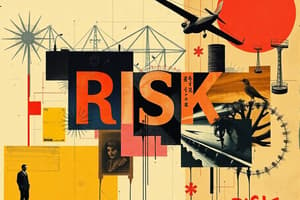Podcast
Questions and Answers
What is the primary purpose of risk analysis?
What is the primary purpose of risk analysis?
- To identify, assess, and prioritize risks. (correct)
- To ignore risks that are deemed insignificant.
- To transfer all risks to a third party.
- To eliminate all potential risks.
Risk mitigation strategies aim to increase the likelihood of risks occurring to better prepare for them.
Risk mitigation strategies aim to increase the likelihood of risks occurring to better prepare for them.
False (B)
Name three key areas where risk analysis and policy are important.
Name three key areas where risk analysis and policy are important.
Business, government, healthcare, cybersecurity
__________ risks involve potential losses due to market fluctuations and investments.
__________ risks involve potential losses due to market fluctuations and investments.
Match the following risk types with their descriptions:
Match the following risk types with their descriptions:
Which step in the risk management process involves creating plans to reduce the potential impact of identified risks?
Which step in the risk management process involves creating plans to reduce the potential impact of identified risks?
Policies in risk management primarily serve to create confusion and uncertainty, ensuring flexibility in unforeseen circumstances.
Policies in risk management primarily serve to create confusion and uncertainty, ensuring flexibility in unforeseen circumstances.
What are two benefits of implementing policies in risk management?
What are two benefits of implementing policies in risk management?
Stronger data encryption, employee training, and multi-factor authentication are examples of policies implemented to address __________ risks.
Stronger data encryption, employee training, and multi-factor authentication are examples of policies implemented to address __________ risks.
Match the following challenges in risk analysis with their description:
Match the following challenges in risk analysis with their description:
What is a key element of best practices in risk policy development?
What is a key element of best practices in risk policy development?
Organizations should avoid updating their risk strategies to maintain consistency.
Organizations should avoid updating their risk strategies to maintain consistency.
Name two best practices in the development of risk policies.
Name two best practices in the development of risk policies.
A proactive approach to risk analysis ensures __________, sustainability, and competitive advantage.
A proactive approach to risk analysis ensures __________, sustainability, and competitive advantage.
Match the step in the Risk Management Process with its corresponding action:
Match the step in the Risk Management Process with its corresponding action:
Which type of risk involves threats such as natural disasters and climate change?
Which type of risk involves threats such as natural disasters and climate change?
Risk identification only needs to occur once during the risk management process.
Risk identification only needs to occur once during the risk management process.
What is the purpose of 'Risk Monitoring' in risk analysis?
What is the purpose of 'Risk Monitoring' in risk analysis?
_____ set guidelines and procedures for managing risks
_____ set guidelines and procedures for managing risks
Connect the examples with the Risk Policy:
Connect the examples with the Risk Policy:
Flashcards
Risk Analysis
Risk Analysis
The process of identifying, assessing, and prioritizing risks.
Policy in Risk Management
Policy in Risk Management
A structured approach to mitigate risks, ensuring consistent and effective risk management practices.
Risk Identification
Risk Identification
Recognizing potential risks that could impact an organization.
Risk Assessment
Risk Assessment
Signup and view all the flashcards
Risk Mitigation
Risk Mitigation
Signup and view all the flashcards
Risk Monitoring
Risk Monitoring
Signup and view all the flashcards
Financial Risks
Financial Risks
Signup and view all the flashcards
Operational Risks
Operational Risks
Signup and view all the flashcards
Strategic Risks
Strategic Risks
Signup and view all the flashcards
Cybersecurity Risks
Cybersecurity Risks
Signup and view all the flashcards
Environmental Risks
Environmental Risks
Signup and view all the flashcards
Role of policies in risk Management
Role of policies in risk Management
Signup and view all the flashcards
Risk assessments and audits
Risk assessments and audits
Signup and view all the flashcards
Cybersecurity Risk Policy
Cybersecurity Risk Policy
Signup and view all the flashcards
Study Notes
- Risk analysis and policy are essential for understanding risk management in decision-making.
Introduction
- Risk analysis is the process of identifying, assessing, and prioritizing risks.
- Policy in risk management provides a structured approach to mitigate risks.
- Key areas for risk management include business, government, healthcare, and cybersecurity.
Key Concepts in Risk Analysis
- Risk identification involves recognizing potential risks.
- Risk assessment involves evaluating the likelihood and impact of risks.
- Risk mitigation involves strategies to minimize risks.
- Risk monitoring involves ongoing tracking and adaptation to risks.
Types of Risks
- Financial risks include market fluctuations and investment risks.
- Operational risks include system failures and human errors.
- Strategic risks include business competition and policy changes.
- Cybersecurity risks include data breaches and hacking threats.
- Environmental risks include natural disasters and climate change.
Risk Management Process
- Identify risks through internal and external analysis.
- Evaluate and prioritize risks based on impact and probability.
- Develop risk mitigation strategies.
- Implement policies, procedures, and controls.
- Continuously monitor and reassess risks.
Role of Policy in Risk Management
- Policies set guidelines and procedures for managing risks.
- Policies ensure compliance with laws and regulations.
- Policies provide a clear framework for decision-making.
- Examples of risk policies include corporate risk policies, government regulations, and cybersecurity policies.
Case Study - Cybersecurity Risk Policy
- Scenario: A data breach occurs at a major corporation due to a lack of security measures.
- Policy implemented: Stronger data encryption, employee training, and multi-factor authentication.
- Outcome: Improved security, reduced breaches, and increased customer trust.
Challenges in Risk Analysis and Policy Implementation
- Uncertainty in risk prediction and evolving threats.
- Resistance to change in organizations.
- Lack of awareness and training among stakeholders.
- Balancing risk mitigation with innovation and growth.
Best Practices in Risk Policy Development
- Conduct regular risk assessments and audits.
- Develop clear and enforceable policies with defined responsibilities.
- Train employees on risk awareness and response strategies.
- Leverage technology for risk monitoring.
- Continuously update policies.
Conclusion
- Risk analysis is essential for informed decision-making.
- Policies provide a structured approach to risk management.
- Organizations must continuously evolve their risk strategies.
- A proactive approach ensures resilience, sustainability, and competitive advantage.
Studying That Suits You
Use AI to generate personalized quizzes and flashcards to suit your learning preferences.




